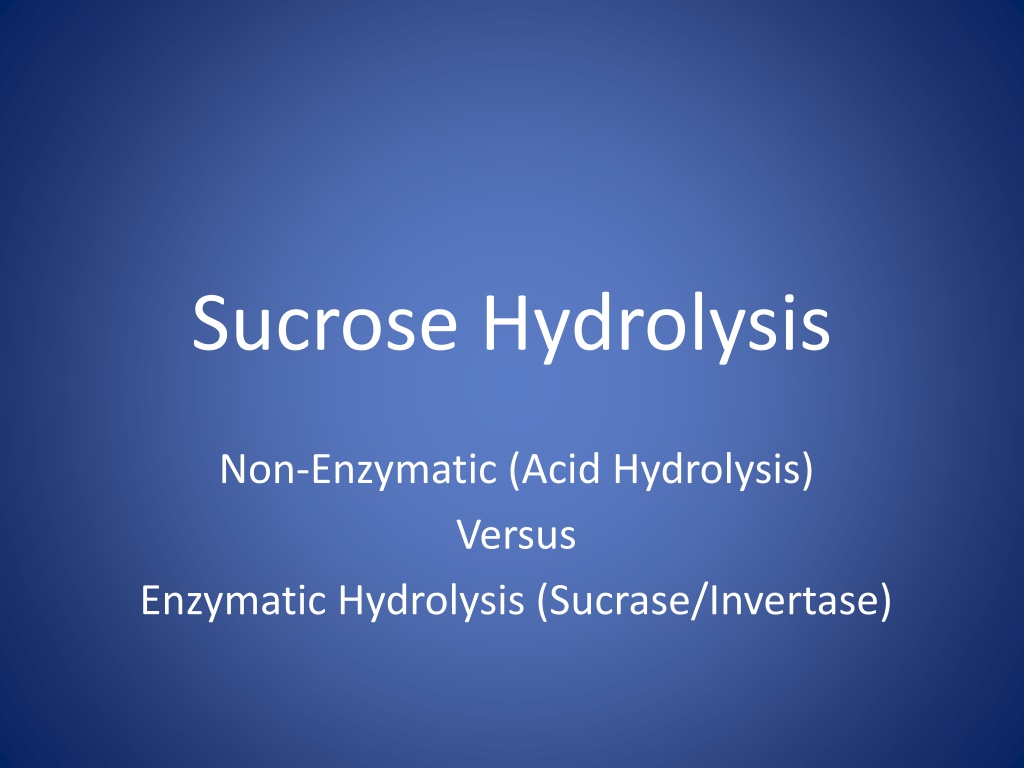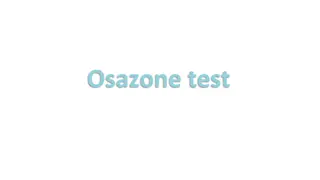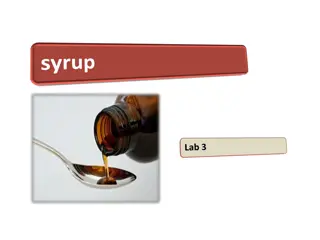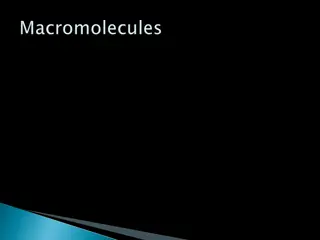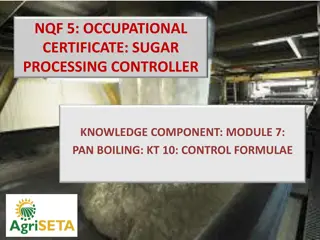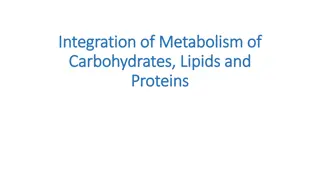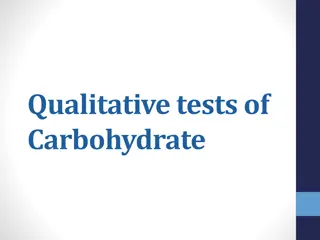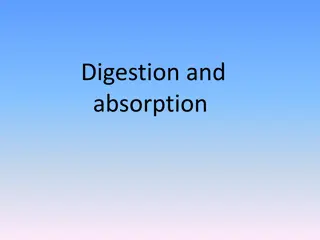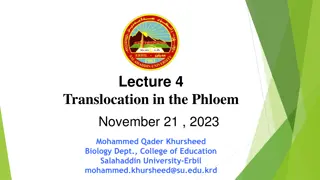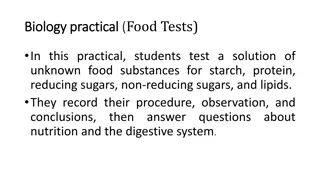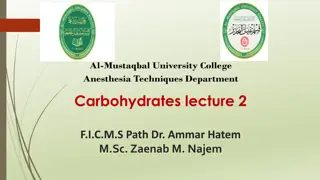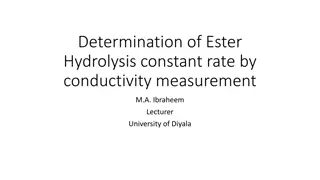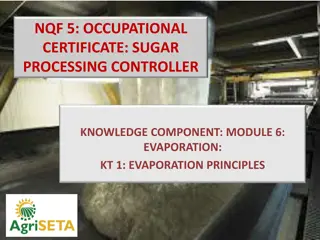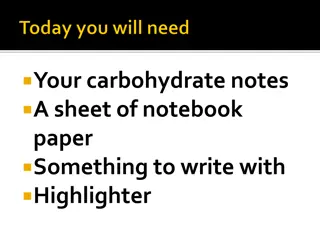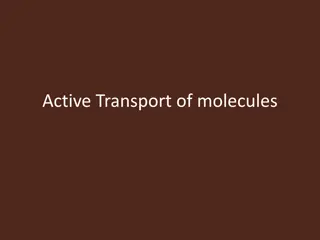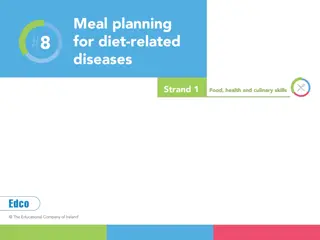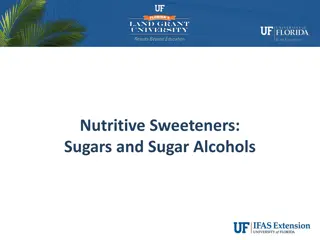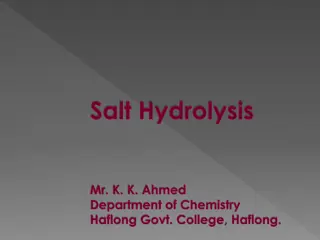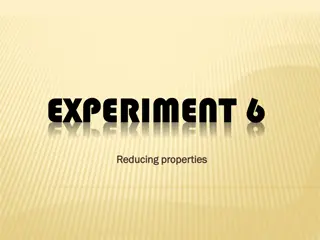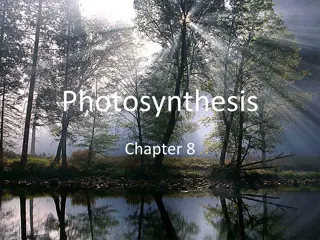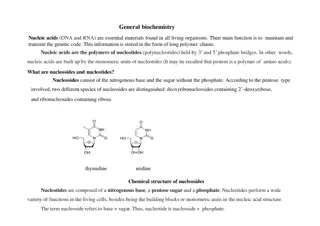Understanding Sucrose Hydrolysis and Reducing Sugars in Carbohydrate Chemistry
This content delves into the mechanisms of sucrose hydrolysis through non-enzymatic and enzymatic processes, highlighting disaccharides like sucrose, lactose, and maltose. It explores the significance of glycosidic bonds in carbohydrate structures and discusses the reducing capacity of sugars such as glucose and fructose. Chemical properties of reducing sugars and methods for analysis using spectrophotometry are also elucidated, providing a comprehensive overview of carbohydrate chemistry.
- Carbohydrate Chemistry
- Sucrose Hydrolysis
- Reducing Sugars
- Glycosidic Bonds
- Spectrophotometric Analysis
Download Presentation

Please find below an Image/Link to download the presentation.
The content on the website is provided AS IS for your information and personal use only. It may not be sold, licensed, or shared on other websites without obtaining consent from the author. Download presentation by click this link. If you encounter any issues during the download, it is possible that the publisher has removed the file from their server.
E N D
Presentation Transcript
Sucrose Hydrolysis Non-Enzymatic (Acid Hydrolysis) Versus Enzymatic Hydrolysis (Sucrase/Invertase)
Fischer Projection of a-D-Glucose Reducing End of Glucose/Fructose Haworth Projection of a-D-Glucose Chair form of a-D-Glucose
Disaccharides Bonds between sugar units are termed glycosidic bonds, and the resultant molecules are glycosides. The linkage of two monosaccharides to form disaccharides involves a glycosidic bond. The important food disaccharides are sucrose, lactose, and maltose. No reducing capacity Reducing ends are not exposed due to 1,2 bond Sucrose: prevalent in sugar cane and sugar beets, is composed of glucose and fructose through an -(1,2) glycosidic bond.
Both are reducing sugarsso we could do this in milk Lactose: is found exclusively in the milk of mammals and consists of galactose and glucose in a -(1,4) glycosidic bond.
and in starch hydrolysis reactions to monitor glucose production in making corn syrup! Maltose: Is the major degradation product of starch, and is composed of 2 glucose monomers in an -(1,4) glycosidic bond.
Chemical Properties of Reducing Sugars Reducing Sugars Some monosaccharides can act as Reducing Agents (electron donators). (I.e. Glucose and Fructose) They reduce Fehling s, Tollen s, or Folin s Reagents We will use these properties of sugars for understanding their physical properties.
Examples of Reducing Sugars and Non- Reducing Sugars REDUCING D-glucose D-fructose Galactose Maltose Maltotriose NON-REDUCING Sucrose Raffinose Cellulose Amylopectin Larger dextrins
Chemical Methods (Spectrophotometric) Simple phenols will react with reducing sugars under the right pH and temperature conditions to product a colored chromaphore that can be read on a spectrophotometer. Refer to your Food Analysis course.
Chemical Methods 3,5-DINITROSALICYLIC ACID reacts with reducing sugars in alkali to form brown-red color that can be measured on a spec H O RESORCINOL (a phenol) reaction is primarily with ketoses to form a colored complex OH Structure ORCINOL (a phenol) reacts with pentoses with 5X more color than hexoses
To the extreme Some methods detect the reaction of going toooo far with the sugar hydrolysis PHENOL mixed with SULFURIC ACID and heated with digest carbohydrates to create furans (furfural, 5-hydroxymethyl furfural, furaldehyde) which condenses with phenol into a near pink color.
Going Tooo Far In today s lab, we want to optimally hydrolyze sucrose. The goal is to get the MOST glucose and fructose possible (competition?) Too gentle, and no reducing sugar is created Too harsh, and you will break-down your reducing sugars into aldehydes. Aldehydes will not react with 3,5-DNSA
Beers Law: States that as absorbance increases, so does concentration A = bc or just A = abc A = absorbance = extinction coefficient b = light path distance c = concentration We are using a standard curve, generated from pure glucose, so: A = C When using 200 L of reactant in a microplate.
Maximum Level of Beers Law Actual Cutoff is Dependent on the Given Assay Linear Cut-Off for Beer's Law in a Given Assay 0.6 0.5 Absorbance 0.4 0.3 0.2 0.1 0 0 2 4 8 16 62 64 132 264 Concentration Stay within a linear range ..too much reducing sugar and you can not get an accurate reading (may need to dilute your sample more)
Glucose Standard Curve The slope of your standard curve is: 0.00051 1.4 y = 0.0005x R = 0.9989 1.2 1 0.8 Abs 0.6 0.4 0.2 0 0 500 1000 1500 2000 2500 3000 Concentration (mg/L or ppm)
Case Study: Hydrolysis in Orange Juice Sucrose hydrolysis occurs quite frequently in OJ. Sucrose inverts or hydrolyzes to form 1 molecule of glucose and 1 of fructose from the heat of processing and natural organic acids. Results in changes to sweetness and degradation Fructose and glucose are then succeptable to degradation (HMF formation). HMF results in brown color formation, a smelly aroma, and a bitter/medicinal taste. Based on your lab group s data, how easy/hard would it be for OJ to have inverted sucrose and/or reducing sugar degradation?
Todays Lab Details Everybody run trials for 0, 15, 30, 45, and 60 mins Group Acid Temp C Group Enzyme Temp C 1 L, H 40 8 L, H 40 2 L, H 50 9 L, H 50 3 L, H 60 10 L, H 60 4 L, H 70 11 L, H 70 5 L, H 50 12 L, H 50 6 L, H 60 13 L, H 60 7 L, H 70 14 L, H 70 Get your water-bath going and regulated ASAP !!!!
